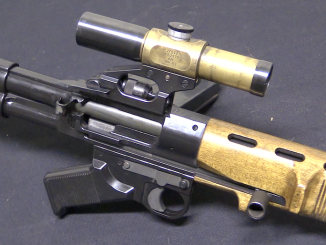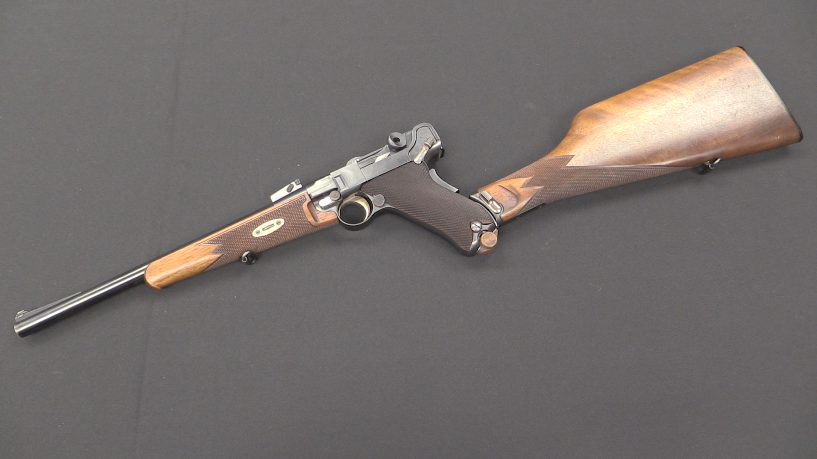Germany developed its first 37mm (or as German designations put it, 3.7cm) antitank gun in the last months of World War One; a very simple design built using barrels from obsolete Hotchkiss revolving cannons. In the mid 1920s, the concept was reinvigorated by Rheinmetall, which developed a much more modern 37mm gun using a much larger and higher-pressure case (37 x 249mm). In its initial pattern, the Tak as it was called (Tankabwerhkanone) has wooden spoke wheels and non suspension, intended for transport by horse. A small number were made for the German military (to avoid aggravating the conditions of the Treaty of Versailles), and the gun was sold commercially by Rheinmetall. The Soviet Union in particular was interested, and used the 3.7cm Tak as the basis for its later 45mm antitank gun.
Between 1934 and 1936, a number of changes were made to the design. The wooden wheels were replace with steel wheels and pneumatic rubber tires, and spring suspension was added to allow the gun to be towed at higher speed by motor vehicles. The designation also changed at the time from tank-abwehrkanone to panzer-abwehrkanone, as the new term “panzer” entered the German military parlance. Under Germany’s 1930s rearmament program, the Versailles limitations were ignored, and Pak production took off. By September of 1939, the German military has some 11,200 of the guns in service. They were solid dependable guns at the beginning of World War Two, but became obsolete by 1941 as tank armor began to rapidly increase. A new tungsten-core AP round was introduced in 1940, and a rfile-grenade-like hollow charge munition (the stielgranate 41) added in 1941, but there was stopgaps at best. The last few 3.7mm Paks were built in early 1942, as both it and the 50mm Pak 38 were phased out in favor of the 75mm Pak 40 antitank gun.
There is an excellent article on the development and use of the 3.7cm Pak at Tank Archives.
I’d like to thank DriveTanks.com for giving me the opportunity to bring you their 3.7mm Pak! They have a very cool collection of armored vehicles, artillery, and machine guns available for rental in Texas; check them out!




What really put the 5cm Pak out of business was the 1943 Fuhrerbefehl restricting tungsten to machine tool fabrication. Without tungsten shot (composite rigid), the 5cm simply couldn’t penetrate the front armor of the later Russian tanks. The 7.5cm finished up the war firing plain ballistic-capped steel shot. On the Allied side, there was no such shortage, and both U.S. and British AT guns fired tungsten-cored shot right through the war.
As for the oversized “rifle grenade” of the 3.7cm, another problem was that nose fuse. The hollow charge effect penetrates by creating what amounts to a self-forging penetrator composed of its metal liner that punches through the armor. A nose fuse does a terrific job of getting in the way, breaking up the penetrator mass before it gets to the armor.
It was for this reason that the U.S. M9 HEAT rifle grenade had a base fuse behind the warhead, and most hollow-charge munitions since then have followed its example.
cheers
eon
“(…)A nose fuse does a terrific job of getting in the way, breaking up the penetrator mass before it gets to the armor. (…)”
Nonetheless Stielgranate 41 penetration was 180 mm at angle 30 degree (Soviet style, 0 = perpendicular hit). This due to geometry is equivalent to 208 mm of not angled armour.
An exceptionally well designed gun – if somewhat on the peacetime luxurious end. As reflected by its widespread adoption or copying. The hollow charge round easy to criticize. But recall that designed-produced in a hurry and the basic knowledge of hollow charges etc. at the time fragmentary / not yet done e.g. many early designs had much less effective semi circular detonation hollows.
Just while ago I watched Chieftains presentation on Pzkw. III where he mentions this gun as adequate for its time (mid 30s), but later replaced by 5cm KwK 39 https://en.wikipedia.org/wiki/5_cm_KwK_39
That was time where the “top-notch tech” were shots with hardened core; still long way to go to shaped charge. Kind of heavy handed approach but that was all. The one who had higher muzzle velocity was at lead.
I appreciate Ian’s effort to spice up FWs repertoire by light cannons. Good work!
“(…)III(…)5cm(…)”
Actually original vision of H. Guderian called for 5 cm gun, but Waffenamt said: do use 37 mm. Ammunition production easier. For more data see:
https://tanks-encyclopedia.com/ww2/nazi_germany/Panzer_III.php
Thus early Ausf. have 37 mm, but when time has come they easily coped with installation of 5 cm gun.
If all you’re talking about is shooting at tanks and other armored vehicles, generally the solid shot penetrator will be the better choice as a round for a gun, as opposed to the High Explosive Anti Tank (HEAT) aka “hollow charge” round.
The trouble with HEAT in rifled guns is that rotational forces tend to degrade formation of the penetrator. Also, penetration effects vary depending on exact materiel and thickness of warhead liner. For a long time, everyone used ordinary mild steel for the liner, and the fact that the U.S. used a tantalum-copper alloy for the liner in the TOW warhead was a closely-guarded secret. Simply put, hollow charge works better in a non-rotating projectile with a fairly large frontal area, like a rocket, missile or “projector” round.
While a smoothbore gun can fire a fin-stabilized HEAT round just as it fires a fin-stabilized penetrator, the gun-launched round will generally have a smaller diameter and thus less frontal area, hence less penetration compared to a high-velocity solid penetrator fired by the same caliber of gun.
The solid shot, provided it is composed of a hard and tough enough material (like tungsten or depleted uranium) and is going fast enough (at least 1,000 to 1,500 m/s) will generally have superior armor-penetration performance to all but the biggest and most sophisticatedly-designed HEAT rounds. Of course, such a solid penetrator requires a pretty serious gun to launch it.
The biggest advantage of the gun is that it generally can kill a tank at considerably greater range than the rocket or missile with a HEAT warhead. Because while the HEAT round doesn’t care much how fast it is going when it hits as far as damage goes, the slower projectile will have a harder job of actually hitting a relatively distant moving target. Penetrators generally have better aerodynamics for long-range shooting, again due to the difference in frontal area.
Factors like this are why, when all is said and done, tanks still have high-velocity guns firing solid projectiles composed of very tough metals.
The HEAT round is mainly useful for platforms that cannot effectively mount such guns. Like for instance a Bradley with a TOW launcher.
Also, guns almost invariably have a higher rate of fire than missile launchers. As a friend of mine who is intimately familiar with TOW and Dragon put it, the first rule of using either one is Don’t Miss With The First Round- because you are unlikely to have time enough to reload and get off a second shot if you do.
A good tank gunner and loader, by comparison, can often have two rounds in the air heading your way inside of ten seconds. It is not an even contest.
cheers
eon
Living 30 mile from Uvalde, TX it is pronounced you-valde by locals for 100+ yrs.
“(…)The Soviet Union in particular was interested, and used the 3.7cm Tak as the basis for its later 45mm antitank gun.(…)”
Actually before that one Soviet Union produced gun even more closely related to German one – namely 1-К: https://en.wikipedia.org/wiki/37_mm_anti-tank_gun_M1930_(1-K)
“(…)and a rfile-grenade-like hollow charge munition (the stielgranate 41) (…)”
I did read somewhere that this was developed for usage during Unternehmen Merkur, to provide air-droppable AT weapon. I am not sure it is true, but seems plausible.
The 7.5 cm Leichtgeschütz 40 recoilless gun was the weapon first deployed with HEAT ammunition during the Crete operation;
https://en.wikipedia.org/wiki/7.5_cm_Leichtgesch%C3%BCtz_40
It was used there by 2. Batterie/Fallschirmjäger-Artillerie-Abteilung (2nd Battery/Parachute Artillery Battalion). It continued in use by German paratroop units of both the Luftwaffe and Waffen SS through the rest of the war.
cheers
eon
Germans seems to like idea of over-caliber ammunition – they also introduced Stielgranate 42 for their 15 cm infantry gun: https://en.wikipedia.org/wiki/Stielgranate_42
though this one was demolition not anti-tank.
If I remember correctly, a few 3.7 cm guns were exported to China where the Nationalist troops managed to punch out a few Japanese Type 89 tanks. A stupid urban legend goes that a Chinese PAK gunner accidentally aimed just a bit too high and decapitated a Japanese tank commander. Has anyone else heard similar stories of “oops” done with anti-armor artillery, where the intended victim was clearly the vehicle (and everyone in it) and not the person on top of it?
This projectile has a second fuze, Bd Z 5130 – Bodenzünder 5130
Base detonating graze fuze with a set-back safety that arms upon firing.
This would at least detonate the warhead on impact.
http://www.inert-ord.net/rod02h/stielgr/index.html